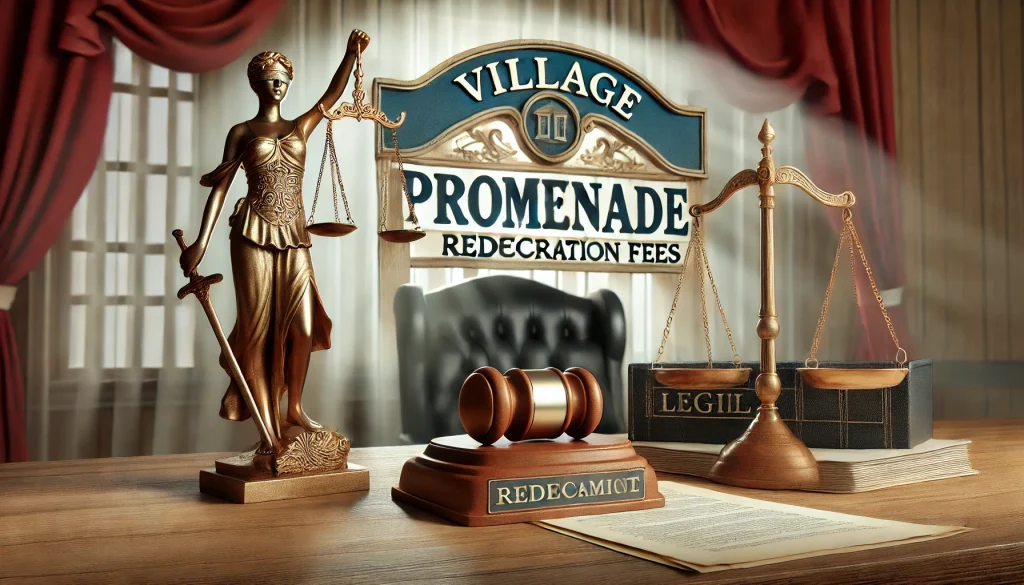The Village Promenade lawsuit over redecorating fees has drawn attention to the complexities of tenant-landlord relationships. The dispute revolves around charges imposed on tenants for property redecoration, leading to legal challenges.
At the heart of the issue is whether the fees were fairly communicated and justified. Tenants claim the charges were excessive and lacked transparency, sparking widespread debate about housing regulations and tenant rights.
Understanding the Village Promenade lawsuit over redecorating fees is essential for tenants and landlords alike, emphasizing the importance of clear agreements and legal compliance in rental contracts.
Origins of the Village Promenade Dispute
The origins of the Village Promenade dispute date back to tenant concerns about unexpected charges for redecoration. Many tenants argued that the fees were not clearly outlined in their rental agreements, creating confusion and frustration.
Initially, the property management company claimed the fees were necessary to maintain the building’s aesthetic standards. However, tenants began to question the lack of transparency in how these fees were calculated and communicated.
Tensions escalated when former residents reported being charged for redecoration even when they left their units in good condition. This raised concerns about whether the fees were justified or arbitrarily applied.
Community discussions and social media posts amplified the issue, drawing attention from tenant advocacy groups. These groups alleged that the charges disproportionately affected students and low-income residents.
Ultimately, the dispute set the stage for a legal battle, as tenants sought clarity and accountability for the imposed fees.
What Sparked the Village Promenade Lawsuit Over Redecorating Fees?
The Village Promenade lawsuit over redecorating fees was triggered by tenants accusing the management of imposing unfair charges. These fees often caught tenants off-guard, particularly when they believed they had fulfilled all move-out requirements.
Key complaints revolved around vague or non-existent explanations of the fees. Tenants claimed that the management failed to provide detailed invoices, sparking suspicion about the legitimacy of the charges.
A contributing factor was the lack of standardization in the charges. Some tenants with minimal wear and tear reported receiving hefty bills, while others with significant damage faced smaller penalties.
Table: Common Tenant Complaints Leading to the Lawsuit
| Complaint | Description | Frequency |
| Lack of Transparency | No breakdown of charges provided | High |
| Charges for Minimal Wear | Fees applied despite good condition of units | Medium |
| Arbitrary Fee Application | Inconsistent charges for similar conditions | High |
| Poor Communication | Little explanation during the lease signing | High |
The lawsuit was officially filed when advocacy groups stepped in, claiming the fees violated tenant protection laws. This action sought to hold the property management accountable and recover excessive charges.
Legal Arguments in the Village Promenade Lawsuit Over Redecorating Fees
The legal arguments in the Village Promenade Lawsuit Over Redecorating Fees center on tenant rights and the obligations of property management companies. At the core of the case is the question of whether the redecoration fees were legally enforceable.
Tenants argued that the charges violated their rental agreements and state housing laws. They claimed that the fees constituted an unfair financial burden, especially since the contracts did not explicitly mention these charges.
The defense countered by stating that the fees were necessary to maintain the property’s quality. They argued that tenants implicitly agreed to the charges by signing the lease, which outlined general upkeep responsibilities.
A significant aspect of the case involves interpreting consumer protection laws. Tenant representatives argue that these laws require clear and transparent fee structures, which were allegedly absent in this case.
The court proceedings will likely hinge on evidence of contractual clarity. Both sides are presenting documentation, including lease agreements and itemized bills, to support their claims.
Understanding Redecorating Fees in Rental Agreements
Redecorating fees are charges that landlords impose on tenants to cover the cost of restoring a property to its original state. These fees often include repainting walls, replacing flooring, or repairing minor damages.
In theory, such fees are meant to ensure that the property remains in rentable condition. However, disputes arise when tenants feel that these charges are unfair or excessive. The Village Promenade lawsuit underscores how unclear fee policies can lead to legal challenges.
Bullet Points: Key Considerations for Redecorating Fees
- Transparency: Fees should be clearly detailed in the lease agreement.
- Reasonableness: Charges must reflect actual damages, not routine wear and tear.
- Communication: Landlords should provide detailed invoices and explanations.
- Legal Compliance: Fees must align with state tenant protection laws.
Tenants are often surprised to learn that routine wear and tear, such as faded paint or carpet wear, typically should not result in additional charges. This misunderstanding can lead to disputes if landlords fail to distinguish between wear and actual damage.
The Village Promenade lawsuit serves as a reminder of the importance of clear communication and proper documentation in rental agreements.
Tenants’ Complaints in the Village Promenade Case
Tenants involved in the Village Promenade case raised numerous concerns regarding the redecoration fees imposed by the management. Many claimed these charges were arbitrary and lacked a proper breakdown, leaving them confused about the rationale behind the amounts.
A recurring complaint was that tenants were billed for redecoration even when they left their apartments in clean and well-maintained condition. These charges often included repainting and minor repairs that tenants believed fell under normal wear and tear.
Additionally, tenants expressed frustration over poor communication from the management. Some claimed they only learned about the fees after moving out, with no opportunity to dispute or negotiate the charges.
Table: Common Tenants’ Complaints
| Complaint Type | Example | Impact |
| Arbitrary Charges | Fees for units in good condition | Financial strain |
| Lack of Transparency | No itemized breakdown of costs | Increased disputes |
| Retroactive Notification | Informed about charges after move-out | Tenant dissatisfaction |
| Unclear Lease Agreements | Vague terms regarding redecoration fees | Legal challenges |
Tenants also criticized the inconsistency in fee application. Similar cases of wear and tear reportedly resulted in vastly different charges, which heightened the perception of unfairness.
Landlord Obligations Highlighted by the Village Promenade Lawsuit
The Village Promenade Lawsuit Over Redecorating Fees sheds light on several key obligations that landlords must fulfill to avoid disputes over redecoration fees. One of the primary responsibilities is maintaining transparency in the lease agreement. Landlords are required to clearly outline all potential charges, including redecoration fees.
Another critical obligation is to differentiate between normal wear and tear and actual tenant-caused damages. Legal experts emphasize that landlords cannot charge tenants for standard depreciation, such as faded paint or worn-out carpets.
Proper communication is also a cornerstone of landlord responsibilities. Tenants involved in the case argued that they were not adequately informed about fee policies, which undermines trust and accountability.
Landlords are further obligated to provide itemized invoices for any charges. This ensures tenants understand the basis of the fees and can contest them if they appear unjustified.
By failing to meet these obligations, landlords risk legal action, as demonstrated in the Village Promenade case, where tenants demanded greater accountability and fairness.
Court Decisions in the Village Promenade Lawsuit
The Village Promenade Lawsuit Over Redecorating Fees resulted in a series of legal findings that highlighted the rights of tenants and the responsibilities of landlords. Early court rulings focused on whether the fees violated tenant protection laws.
The court determined that the management failed to provide adequate documentation for the charges, making it difficult for tenants to assess the validity of the fees. This ruling emphasized the importance of clear and transparent record-keeping.
In another significant decision, the court acknowledged the tenants’ argument that redecoration fees for normal wear and tear are not enforceable. It noted that landlords must distinguish between routine maintenance and damages caused by negligence.
Key Court Findings
- Transparency: Fees must be itemized and justified with evidence.
- Legal Boundaries: Normal wear and tear cannot be charged to tenants.
- Communication: Proper notification about fees is mandatory before the lease ends.
The court’s rulings in favor of the tenants have set a precedent, influencing other rental disputes. The case also reinforced the necessity for landlords to adhere to state housing regulations.
Financial Impact of Redecorating Fees on Tenants and Management
The financial impact of the redecoration fees on tenants and management was a central issue in the lawsuit. Tenants argued that these fees placed an undue financial burden on them, particularly those on tight budgets.
For tenants, the unexpected nature of the charges meant additional stress at the end of their leases. Many had to use their security deposits to cover the fees, leaving them with little or no refund.
On the management side, the lawsuit incurred significant legal expenses, along with reputational damage. Negative publicity surrounding the case discouraged potential renters, affecting occupancy rates and revenue.
Bullet Points: Financial Effects
- Tenants:
- Loss of security deposit.
- Increased moving-out expenses.
- Potential credit score impact for unpaid fees.
- Management:
- Legal fees and settlement costs.
- Decline in tenant trust and property reputation.
- Reduced long-term revenue due to tenant turnover.
This case underscores the importance of fair and transparent fee policies. Clear communication and proper legal compliance could have mitigated these financial repercussions for both parties.
Lessons Learned From the Village Promenade Legal Dispute
The Village Promenade legal dispute offers several important lessons for tenants, landlords, and property managers. One key takeaway is the significance of clear and transparent communication. Ambiguity in lease agreements, particularly regarding fees, can lead to misunderstandings and disputes.
Tenants learned the importance of reading lease agreements carefully and seeking clarification about any unclear terms before signing. Being proactive in understanding rights and responsibilities can prevent issues later.
For landlords, the dispute highlighted the need for detailed and itemized explanations of charges. Providing clear documentation for redecoration fees or any other post-lease charges ensures accountability and reduces the likelihood of legal challenges.
The case also underscored the importance of distinguishing between normal wear and tear and tenant-caused damage. Legal interpretations of these terms can heavily influence the outcome of disputes.
Finally, the dispute demonstrated the value of tenant advocacy and the role of legal protections in ensuring fair treatment. Advocacy groups played a significant role in bringing attention to tenant concerns, which ultimately led to legal reform.
Broader Implications of the Lawsuit on Rental Practices
The Village Promenade Lawsuit Over Redecorating Fees has broader implications for rental practices, particularly concerning fee policies and tenant rights. One significant impact is the increased scrutiny landlords now face regarding their fee structures.
Property managers may need to revise their lease agreements to ensure compliance with housing laws. This includes providing transparent explanations for all fees and ensuring tenants have access to this information before signing a lease.
The lawsuit also prompted a shift toward tenant-focused policies. Landlords are now more likely to offer detailed move-in and move-out checklists to document the condition of rental units. These checklists can help reduce disputes over damages and associated fees.
Table: Broader Implications on Rental Practices
| Aspect | Pre-Lawsuit Practices | Post-Lawsuit Changes |
| Fee Transparency | Vague or hidden charges | Clear and itemized breakdowns |
| Lease Clarity | Ambiguous terms | Detailed agreements with defined fees |
| Tenant Advocacy | Limited legal recourse | Stronger legal protections for tenants |
| Inspection Standards | Inconsistent practices | Standardized move-in/move-out checks |
The lawsuit’s publicity also encouraged tenants to educate themselves about their rights, leading to a more balanced tenant-landlord dynamic.
How the Village Promenade Lawsuit Sets a Precedent
The Village Promenade lawsuit has established a significant legal precedent, particularly regarding the enforceability of redecoration fees. Courts now place greater emphasis on the need for landlords to provide clear and detailed justifications for any charges imposed on tenants.
This case is likely to influence future rulings, with judges referencing it to evaluate whether landlords have complied with transparency and fairness requirements. The decision also reinforced the principle that landlords cannot charge for normal wear and tear, which remains a tenant protection standard.
In addition, the case has encouraged legislative discussions at local and state levels. Lawmakers are exploring ways to strengthen tenant rights and ensure clearer fee policies in rental agreements.
Another precedent set by the lawsuit is the role of tenant advocacy groups. These organizations demonstrated their ability to influence legal outcomes by representing collective tenant concerns effectively.
The ripple effects of this case are already evident in other disputes, as tenants and landlords reference its outcomes to argue their positions.
Avoiding Disputes Over Redecorating Fees in the Future
Avoiding disputes like those seen in the Village Promenade Lawsuit Over Redecorating Fees requires proactive measures by both tenants and landlords. The most critical step is ensuring that lease agreements are clear, detailed, and transparent about all potential charges, including redecoration fees.
Landlords can minimize disputes by providing tenants with a move-in checklist to document the unit’s condition. This checklist should be updated during move-out inspections to compare the state of the property.
Bullet Points: Best Practices for Avoiding Fee Disputes
- For Landlords:
- Clearly outline all fees in the lease agreement.
- Use standardized checklists for inspections.
- Provide itemized invoices for any charges.
- For Tenants:
- Document the condition of the unit at move-in and move-out.
- Ask for clarification about fee policies before signing the lease.
- Keep copies of all communication with landlords.
Another effective strategy is open communication. Regular updates and timely responses to tenant concerns can build trust and reduce the likelihood of misunderstandings.
Ultimately, avoiding disputes requires a collaborative approach where both parties understand and respect their rights and responsibilities. The Village Promenade lawsuit serves as a reminder of the importance of fairness and transparency in rental practices.
Conclusion
The Village Promenade Lawsuit Over Redecorating Fees highlights the critical need for transparency and fairness in tenant-landlord relationships. The case underscored the importance of clear lease agreements that explicitly outline potential charges and distinguish between routine wear and tear and tenant-caused damages.
For tenants, the lawsuit reinforced the value of understanding their rights and responsibilities before signing a lease. Being proactive in documenting property conditions and seeking clarity on ambiguous terms can prevent future disputes. Similarly, landlords can benefit from adopting transparent practices and maintaining open communication with tenants to avoid misunderstandings.
The broader implications of the case have set a precedent for rental practices across the housing industry. By emphasizing legal compliance, accountability, and fairness, the lawsuit serves as a benchmark for improving tenant-landlord dynamics and reducing conflicts.
Recommended Articles:
Bank of America Faces a New Lawsuit from UBS: Could This Be a Turning Point for the Banking Sector?
Wichita Mesothelioma Lawyer Vimeo: How Video Resources Help Victims Navigate Legal Challenge




